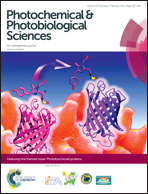Triplet state quenching of phenosafranine dye by indolic compounds studied by transient absorption spectroscopy
Abstract
The interaction of the triplet state of the synthetic dye phenosafranine (3,7-diamino-5-phenylphenazinium chloride) with indolic compounds of biological relevance was investigated in water by means of laser flash photolysis. The rate constants for the triplet quenching were determined. The quenching process may be explained by an electron transfer from the indole to the dye in its triplet state. The rate constants present a typical dependence of an electron transfer process with the one-electron oxidation potential of the indole. Indole-3-acetic acid and its homologous indole propionic and indole butyric acids are the most effective quenchers with rate constants reaching the diffusion limit. Rate constants for indole itself, tryptophan and indole-3 carboxylic acid are one order of magnitude lower. The electron transfer nature of the quenching reaction is further confirmed by the detection of the semi-reduced form of the dye by its transient absorption. The absorption coefficients of the transient species were estimated, and the quantum yield of the charge separation process was determined. The efficiency of formation of radical species is between 60 and 90% of the triplets intercepted.


 Please wait while we load your content...
Please wait while we load your content...